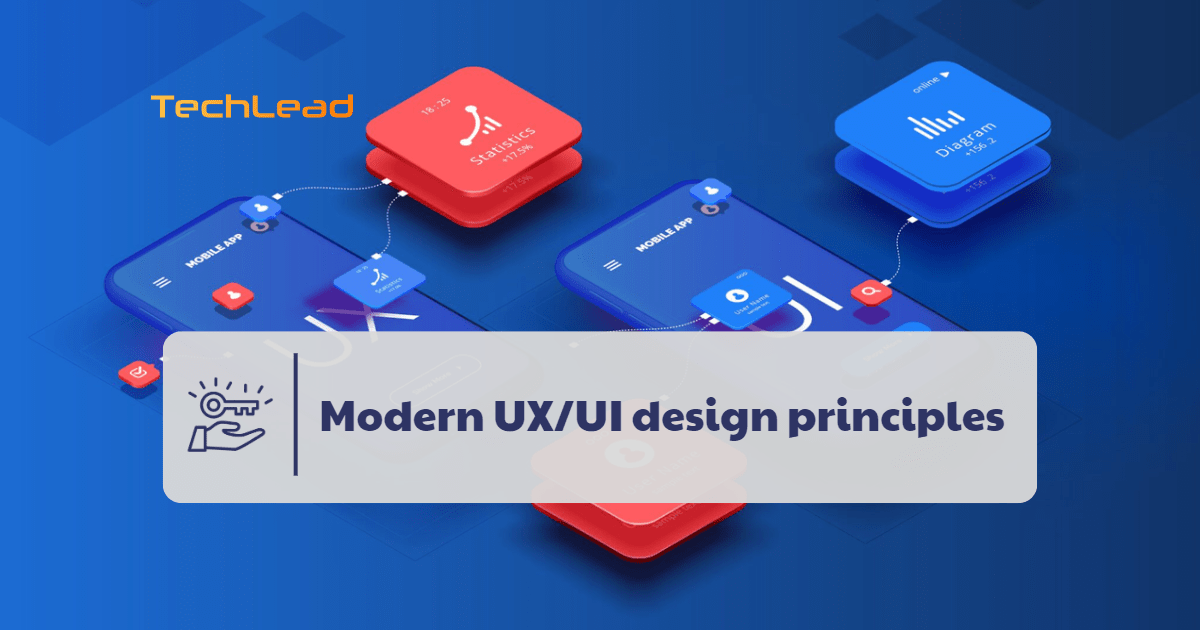In modern design practices, UX/UI are indispensable components that collectively contribute to the overall success of digital products. Their collaboration is important because this integration ensures that functionality and aesthetics work in harmony to deliver exceptional user experiences, thereby enhancing user retention and satisfaction. in today’s competitive design landscape. This article will cover “Modern UX/UI design principles”
The definition of UI/UX
The definition of UI/UX (Collected)
User Experience (UX) and User Interface (UI) are pivotal components in modern design, each serving distinct yet interrelated roles in creating compelling digital experiences. UX encompasses the overall experience that a user has with a product or service, focusing on aspects such as usability, accessibility, and satisfaction. It involves understanding user behaviors, needs, and motivations through various research methods like user interviews, usability testing, and analytics. UX design aims to ensure that interactions between the user and the product are intuitive, efficient, and delightful.
On the other hand, UI refers to the specific assets and elements through which users interact with a product or service. It includes visual elements such as buttons, icons, typography, color schemes, and layout design. UI design focuses on enhancing the usability and aesthetic appeal of these elements to facilitate smooth and enjoyable user interactions. Effective UI design not only makes interfaces visually appealing but also ensures that they are functional and accessible to diverse user demographics.
The synergy between UX/ UI is critical in contemporary design practices as it determines the overall success and acceptance of digital products. While UX addresses the holistic experience and satisfaction of users, UI translates those principles into tangible interface elements that users engage with. By integrating UX research findings into UI design decisions, designers can create interfaces that not only look aesthetically pleasing but also function seamlessly to meet user needs and expectations.
In conclusion, the integration of UX/UI principles is indispensable in modern design to achieve user-centricity and product excellence. By understanding the distinctions between UX/UI and leveraging their combined strengths, designers can craft cohesive digital experiences that resonate with users and drive business success.
Basic principles of UX/UI
In modern UX/UI design, adhering to fundamental principles such as simplicity, user-centered design, and employing user-centric tools and techniques is paramount to creating intuitive and effective digital experiences.
Basic principle of UX/UI (Collected)
1. Simplicity in UX/UI Design
Simplicity in UX/UI Design (Collected)
Simplicity is not merely about minimalism or reductionism in design elements; it encompasses a strategic approach to streamline user interactions and optimize usability. In UX/UI design, simplicity ensures that users can navigate interfaces effortlessly, comprehend content intuitively, and achieve their goals without unnecessary complexity. This principle acknowledges that overly complicated designs can lead to user frustration, abandonment, and a negative perception of the product or service.
To achieve simplicity in UX/UI design, practitioners focus on several key strategies. Firstly, they prioritize essential functionalities and content while eliminating extraneous elements that do not contribute to the user journey. This involves conducting thorough user research to understand user needs, preferences, and pain points. By incorporating user feedback early in the design process, designers can iteratively refine interfaces to align with user expectations and behaviors.
Secondly, designers utilize intuitive navigation structures and information architecture to guide users seamlessly through the interface. Clear and concise labeling, logical grouping of content, and consistent design patterns further enhance usability and reduce cognitive load. Visual hierarchy plays a crucial role in directing user attention and emphasizing important information, thereby facilitating efficient information retrieval and decision-making.
Furthermore, leveraging whitespace and thoughtful use of typography and color palettes contribute to visual clarity and readability. Effective use of whitespace not only enhances visual appeal but also improves comprehension and focus on key interface elements. Typography choices ensure legibility across different devices and screen sizes, enhancing accessibility and usability for diverse user demographics.
In essence, simplicity in UX/UI design involves a holistic approach to optimizing user experiences by prioritizing clarity, usability, and functionality. By adhering to this principle, designers can create interfaces that are not only aesthetically pleasing but also intuitive and user-friendly, ultimately fostering positive user interactions and engagement.
2. User-Centered Design
User-centered design (UCD) is a methodology that prioritizes the needs and preferences of end-users throughout the design process. It emphasizes empathy for users’ perspectives, behaviors, and goals to create solutions that meet their specific requirements effectively.
Central to UCD is the iterative process of understanding, designing, prototyping, and testing with real users. Designers employ various research methods such as interviews, surveys, usability testing, and analytics to gather qualitative and quantitative data about user behaviors and preferences. This empirical approach ensures that design decisions are informed by actual user insights rather than assumptions or preferences of the design team.
By conducting user research, designers gain valuable insights into user motivations, pain points, and expectations. These insights inform persona development, journey mapping, and scenario analysis, enabling designers to empathize with users and design experiences that resonate with their needs. Through iterative prototyping and usability testing, designers validate design assumptions, identify usability issues, and refine interfaces to enhance usability and user satisfaction.
Effective implementation of UCD involves cross-functional collaboration among designers, researchers, developers, and stakeholders. By fostering a user-centric mindset within the team, organizations can prioritize user experience as a strategic advantage and drive business success through customer satisfaction and loyalty.
3. User-Centric Tools and Techniques
In the realm of UX/UI design, employing user-centric tools and techniques is essential to optimizing user experiences and achieving design objectives effectively. These tools encompass a wide range of methodologies, frameworks, and software applications that facilitate user research, prototyping, usability testing, and iterative design improvements.
Common user-centric tools in UX/UI design include:
Wireframing and Prototyping Tools
Software applications like Sketch, Adobe XD, and Figma enable designers to create low-fidelity wireframes and interactive prototypes. These tools facilitate rapid iteration and visualization of design concepts, allowing designers to gather early feedback from stakeholders and users.
Usability Testing Platforms
Platforms such as UsabilityHub, UserTesting, and Optimal Workshop provide tools for remote usability testing, moderated and unmoderated user research sessions, and heatmaps. These tools help designers validate design decisions, identify usability issues, and gather qualitative feedback from target users.
Analytics and Heatmap Tools
Tools like Google Analytics, Hotjar, and Crazy Egg offer insights into user behavior, navigation patterns, and interaction with digital interfaces. By analyzing metrics such as bounce rates, conversion rates, and click-through rates, designers can optimize UX/UI design elements to improve user engagement and achieve business goals.
Collaboration and Communication Tool
Collaboration platforms such as Slack, Trello, and Asana facilitate communication and project management within design teams. These tools enable seamless collaboration, file sharing, and task tracking, promoting transparency and efficiency in design workflows.
By integrating these user-centric tools and techniques into UX/UI design processes, designers can enhance collaboration, streamline workflow efficiencies, and ultimately deliver digital experiences that meet user needs and expectations. Continuous adoption and refinement of these tools empower designers to iterate rapidly, validate design hypotheses, and optimize UX/UI solutions for maximum impact and user satisfaction.
Practice in UX/UI design
Practice in UX/UI design (Collected)
In UX/UI design, the process of Requirements Analysis and Design Planning forms the foundational stage of any project. This phase is crucial as it sets the direction for subsequent design decisions and ensures alignment with user needs and business objectives.
1. Requirements Analysis and Design Planning
Requirements analysis involves gathering, documenting, and analyzing the needs and expectations of stakeholders, users, and the project itself. It encompasses understanding user personas, conducting stakeholder interviews, and reviewing existing analytics to identify pain points and opportunities for improvement. This phase lays the groundwork for designing a solution that addresses real user needs effectively.
Design planning, on the other hand, translates the findings from requirements analysis into a strategic framework for the UX/UI design process. It involves setting project goals, defining scope and deliverables, establishing timelines, and allocating resources appropriately. Clear documentation of design principles, user flows, and feature prioritization ensures a shared understanding among team members and stakeholders.
The importance of this process cannot be overstated. By meticulously defining requirements and planning the design strategy upfront, teams can minimize rework, reduce project risks, and deliver solutions that resonate with users. Effective requirements analysis helps in uncovering hidden user needs and preferences, which are often critical to the success of the product.
2. Prototyping and User Testing
Once the requirements are defined and the design plan is in place, the next critical phase is prototyping and user testing. Prototyping involves creating interactive representations of the final product to simulate its functionality and user interface. This can range from low-fidelity wireframes to high-fidelity mockups, depending on the project stage and complexity.
User testing aims to gather feedback directly from potential users regarding the prototype. It involves setting up scenarios and tasks for users to perform while observing their interactions and collecting qualitative and quantitative data. Feedback can be gathered through usability tests, interviews, surveys, and analytics tools to understand user behavior, preferences, and pain points.
Iterative testing and refinement are key aspects of this phase. By analyzing user feedback and behavior patterns, designers can identify usability issues and areas for improvement in the interface. Iterative prototyping and testing allow for incremental enhancements, ensuring that the final product meets user expectations and usability standards.
In conclusion, the synergy between Requirements Analysis and Design Planning, followed by Prototyping and User Testing, forms the backbone of successful UX/UI design projects. By adhering to a systematic approach and continuously iterating based on user feedback, designers can create intuitive and engaging interfaces that deliver meaningful user experiences. This structured process not only enhances product usability but also increases user satisfaction and loyalty over time.
Trends and Predictions in Modern UX/UI Design
In the rapidly evolving field of UX/UI design, staying abreast of current trends is crucial for creating engaging and effective digital experiences. Here, we explore some of the latest trends and predictions that are shaping the future of UX/UI design, along with practical insights on how to integrate these trends into your design practices.
Trends and Predictions in Modern UX/UI Design (Collected)
1. Modern UX/UI Design Trends
In recent years, UX/UI design has witnessed a significant shift towards more personalized and immersive experiences. One prominent trend is the rise of micro-interactions, which are subtle animations or visual responses that enhance user engagement and provide immediate feedback. These micro-interactions not only delight users but also contribute to a seamless user experience by guiding them through various tasks intuitively.
Another noteworthy trend is the emphasis on dark mode interfaces. Initially popularized by mobile operating systems, dark mode has gained traction across websites and applications due to its aesthetic appeal and potential benefits for reducing eye strain in low-light conditions. Integrating dark mode into UX/UI design requires careful consideration of color contrasts and readability to ensure usability remains optimal across different contexts.
Furthermore, voice user interfaces (VUI) have emerged as a significant trend, leveraging advancements in natural language processing and AI technology. VUIs enable users to interact with devices and applications through voice commands, offering a hands-free and efficient way to navigate digital interfaces. Designing for VUI involves understanding speech patterns, designing clear prompts, and anticipating user intents to deliver seamless interactions.
2. Emerging Trends and Predictions
Looking ahead, several emerging trends are poised to shape the future landscape of UX/UI design. One such trend is inclusive design, which focuses on creating products that are accessible to users of diverse abilities and backgrounds. This includes designing with empathy, considering factors such as cognitive, motor, and sensory impairments to ensure a universally accessible user experience.
Moreover, data-driven design is becoming increasingly prevalent, with designers harnessing analytics and user data to inform design decisions. By analyzing user behavior and preferences, designers can optimize interfaces, personalize content, and anticipate user needs more effectively. This trend underscores the importance of continuous testing and iteration based on real-time insights.
3. Applying These Trends to Your Designs
To effectively incorporate these trends into your UX/UI designs, consider the following strategies:
- Stay Updated: Regularly monitor industry publications, attend conferences, and participate in design communities to stay informed about the latest trends and best practices.
- User Research: Conduct thorough user research to understand your audience’s preferences, behaviors, and pain points. This will guide you in selecting and prioritizing trends that resonate with your user base.
- Iterative Design Process: Adopt an iterative design approach that allows for experimentation and refinement based on user feedback and data insights. This iterative cycle ensures that your designs evolve in line with emerging trends and user expectations.
- Collaboration: Foster collaboration between UX/UI designers, developers, and other stakeholders to brainstorm innovative solutions and ensure seamless implementation of new trends.
By embracing these trends and integrating them thoughtfully into your design process, you can create compelling user experiences that not only meet current expectations but also anticipate future needs in the dynamic landscape of UX/UI design.
Conclusion
In conclusion, adherence to modern UX/UI principles stands as a pivotal factor in the success of digital products today. It is crucial for designers and stakeholders alike to recognize the iterative nature of UX/UI design, wherein continuous testing and refinement are essential for optimizing user interactions. Embracing these principles not only ensures smoother navigation and functionality but also contributes to the overall branding and market positioning of a product or service.
If you want to learn about modern UX/UI design principles but don’t know where to start, please contact TechLead immediately for advice on UX/UI design and software development!






